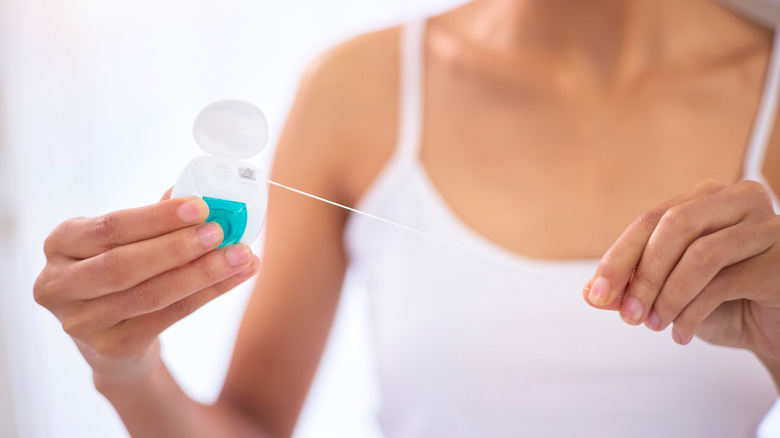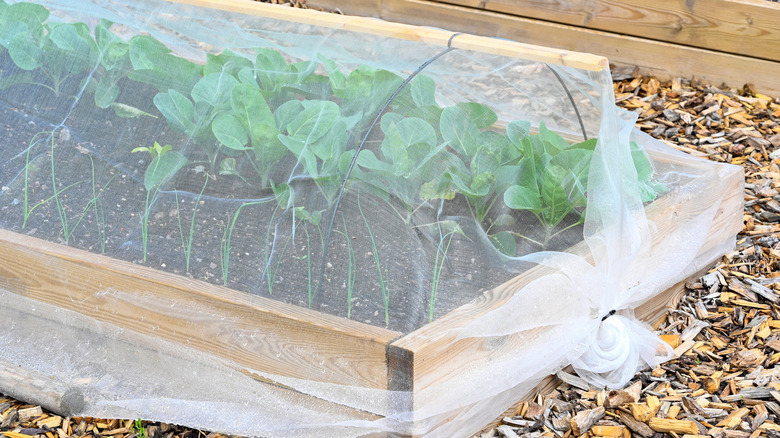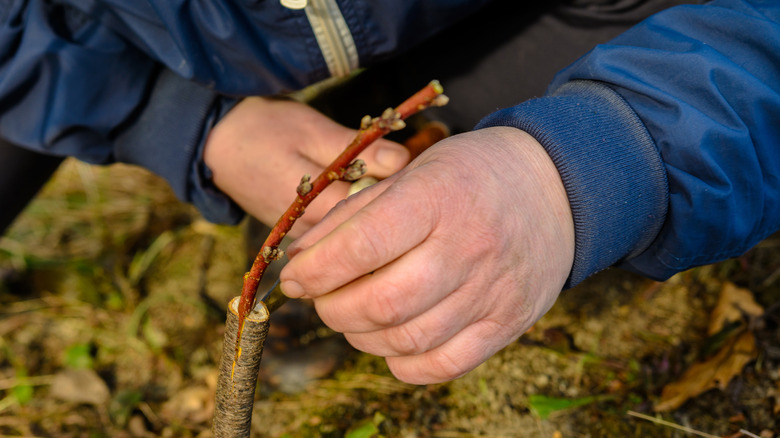Why You Should Stash A Pack Of Dental Floss With Your Gardening Supplies
A good gardener carries a tool belt and knows a handful of tips and tricks to help their plants find success in the garden. One hack that you may not have tried yet is to utilize dental floss as an essential tool in the garden. Dental floss is strong and sturdy and can meet a number of needs, as it can be as short or long as your pack will allow. It's inconspicuous enough not to draw attention but more reliable than you may assume. One technique in particular is to use dental floss to help support climbing plants in your garden. As plants grow, many of them become top-heavy and will tip over if left unsupported. Cucumbers and tomatoes are two notable culprits that require a little extra help in order to stand up straight.
To utilize dental floss as a support for your garden plants, simply cut a 6-inch length of floss and gently tie the stems to stakes or trellises to secure them. Don't tie it too tightly, though, as the stems will become sturdier and require more room to grow throughout the season. As your plants continue to reach for the sky, you will likely need to adjust these supports, adding new ones or loosening any that have become too tight in order to prevent the floss from digging into the plant's flesh, which could leave room for disease or rot to set in. Periodically replace any that need a refresh, too.
Use dental floss to secure row covers
Another use for dental floss in the garden is to help secure row covers around your plants. Row covers are used to shelter plants from cold weather, insects, or wind and are made of a semi-transparent, stretchable fabric that's draped over the plants (and typically, fabric is the best material to help protect your plants from frost). These coverings work best when they are securely held in place so that they don't get blown away, putting your garden at risk.
To use dental floss for this, you'll want to start by positioning your row cover over the designated part of your garden. Next, attach the edges of the row cover to stakes or hoops around the perimeter of the garden bed. As an added measure, use the dental floss to tie the cover securely to these supports, preventing the row cover from blowing away in the wind.
Dental floss is a great hack here because it's strong enough to tolerate moderate tension from wind but gentle enough not to damage the delicate material from which row covers are made. It's a great alternative to metal wire or plastic ties that may damage the cover. It also won't rust in the rain. One thing to note when using floss, or really any material, when you're securing your row cover is not to tie it too tightly. A taut row cover can smother your plants, potentially leading to adverse growth issues.
Use dental floss to graft plants
Another use for dental floss in your garden is for grafting. This is a technique in which two plants are joined together by attaching the top of one plant to the stem of another, creating a new plant altogether. It's commonly used to help improve disease resistance, enhance vigor, or propagate rare species. If you'd like to give this process a try, then you'll need to be sure that the rootstock and the scion — the part of the plant you'll graft to the stem — are compatible species. To get started, make clean cuts on both the rootstock and the scion and make sure they can fit together snugly. Once you've attached the scion to the rootstock, wrap a length of dental floss tightly around the graft to hold the two pieces together in place.
Dental floss is particularly great in this scenario because it's thin, strong, and flexible, providing a secure binding without damaging the tissues of either plant. Unlike some traditional grafting materials like rubber bands or tape, the soft nature of floss is less likely to cause injury or inhibit the flow of nutrients between the two plants. One thing to keep in mind is that you shouldn't tie the floss too tightly. Excessive pressure could damage the graft union or restrict the flow of nutrients. Closely monitor the plant in the following days to be sure the dental floss is still securely in place and that proper healing is developing.


